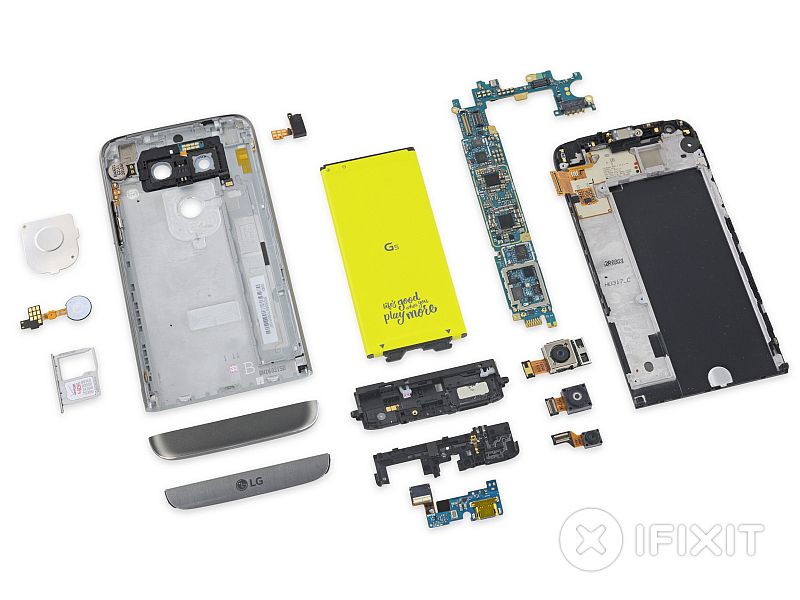- Home
- Mobiles
- Mobiles News
- LG G5 Teardown Gives the Modular Smartphone a High Repairability Score
LG G5 Teardown Gives the Modular Smartphone a High Repairability Score

Unlike the Samsung Galaxy S7, the LG G5 scored a repairability score of 8 out of 10. To recall, Samsung's flagship poor repairability score of 3 out of 10. The teardown suggested that many components in the LG G5 were modular "making for easier, cheaper part replacement".
iFixit noted that the replaceable battery on the G5 minimises the amount of e-waste associated with consumer electronics.
"Replaceable batteries make us happy. They play a huge role in minimizing the amount of e-waste associated with consumer electronics. Not to mention, they add the ability to carry an extra battery, so you don't run out of juice," said the iFixit team. The teardown adds that while the G5 doesn't support Android's adoptable storage, LG's external storage inclusion in its flagship is "another win for longevity and, in all likelihood, a net reduction in e-waste."
Most of the module covers were glued on which meant that making repairs was a bit sticky. "After just two screws and some pry-able clips, we pop open the display with ease. No fuss, no adhesive," added iFixit.
The teardown suggested that the fingerprint scanner on the LG G5 was a bit different from the one seen on the LG-made recent Nexus 5X. Some of the chipsets revealed by the teardown include Samsung K3RG2G20BM-MGCJ 4 GB LPDDR4 RAM, Samsung KLUBG4G1CE-B0B1 32 GB MLC Universal Flash Storage 2.0, NXP 54802 NFC Controller, Qualcomm SMB1350 Quick Charge 3.0 IC, and Qualcomm WSA8815 Audio Codec.
The only complaint folks at iFixit had with the G5 was the fused display assembly would need to be replaced if the LCD or glass break, resulting in increased costs.
Catch the latest from the Consumer Electronics Show on Gadgets 360, at our CES 2026 hub.
Related Stories
- Samsung Galaxy Unpacked 2025
- ChatGPT
- Redmi Note 14 Pro+
- iPhone 16
- Apple Vision Pro
- Oneplus 12
- OnePlus Nord CE 3 Lite 5G
- iPhone 13
- Xiaomi 14 Pro
- Oppo Find N3
- Tecno Spark Go (2023)
- Realme V30
- Best Phones Under 25000
- Samsung Galaxy S24 Series
- Cryptocurrency
- iQoo 12
- Samsung Galaxy S24 Ultra
- Giottus
- Samsung Galaxy Z Flip 5
- Apple 'Scary Fast'
- Housefull 5
- GoPro Hero 12 Black Review
- Invincible Season 2
- JioGlass
- HD Ready TV
- Laptop Under 50000
- Smartwatch Under 10000
- Latest Mobile Phones
- Compare Phones
- OPPO Reno 15 Pro Max
- Honor Win RT
- Honor Win
- Xiaomi 17 Ultra Leica Edition
- Xiaomi 17 Ultra
- Huawei Nova 15
- Huawei Nova 15 Pro
- Huawei Nova 15 Ultra
- Asus ProArt P16
- MacBook Pro 14-inch (M5, 2025)
- OPPO Pad Air 5
- Huawei MatePad 11.5 (2026)
- Xiaomi Watch 5
- Huawei Watch 10th Anniversary Edition
- Acerpure Nitro Z Series 100-inch QLED TV
- Samsung 43 Inch LED Ultra HD (4K) Smart TV (UA43UE81AFULXL)
- Asus ROG Ally
- Nintendo Switch Lite
- Haier 1.6 Ton 5 Star Inverter Split AC (HSU19G-MZAID5BN-INV)
- Haier 1.6 Ton 5 Star Inverter Split AC (HSU19G-MZAIM5BN-INV)


















